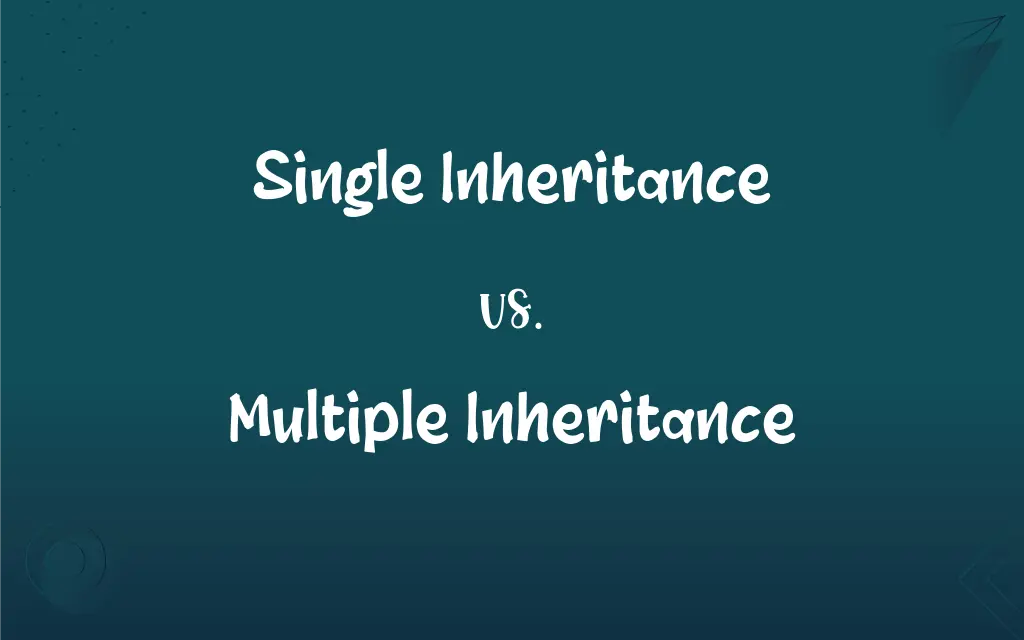Single Inheritance vs. Multiple Inheritance: What's the Difference?
Edited by Aimie Carlson || By Harlon Moss || Updated on October 18, 2023
Single inheritance allows a class to inherit from only one superclass, while multiple inheritance permits a class to inherit from multiple superclasses.

Key Differences
Single inheritance ensures that a class derives its properties and behaviors from only one superclass. On the contrary, multiple inheritance allows a class to inherit features from several superclasses simultaneously.
When using single inheritance, the structure remains simple, avoiding confusion from multiple source inheritance. With multiple inheritance, complexities can arise when a class inherits properties or methods from multiple sources, potentially leading to ambiguity.
In single inheritance, the chance of naming collisions and the diamond problem (a form of ambiguity) is minimized. Multiple inheritance, however, may result in these issues if two superclasses have properties or methods with the same name.
Programming languages like Java and C# support single inheritance to maintain simplicity in class hierarchies. Meanwhile, languages like C++ and Python allow multiple inheritance, offering more flexibility but requiring developers to manage potential complexities.
Adopting single inheritance often leads to clearer hierarchies and reduced ambiguity. In contrast, multiple inheritance, while powerful, can result in tangled inheritance trees if not managed properly.
ADVERTISEMENT
Comparison Chart
Number of Superclasses
Inherits from one superclass
Inherits from multiple superclasses
Complexity
Simpler hierarchy
Potentially more complex hierarchy
Ambiguity Issues
Reduced chance of naming collisions
Can lead to naming collisions and diamond problem
Supported Languages
Java, C#
C++, Python
Hierarchy Clarity
Clearer hierarchies
Can have tangled inheritance trees
ADVERTISEMENT
Single Inheritance and Multiple Inheritance Definitions
Single Inheritance
Restricts inheritance hierarchy to a linear path.
Single inheritance ensures a straight lineage from the Base class to the Derived class.
Multiple Inheritance
Requires careful management to avoid tangled hierarchies.
The software's complex inheritance structure is a result of not optimally using multiple inheritance.
Single Inheritance
Promotes simplicity in object-oriented design.
Opting for single inheritance made the software architecture straightforward and clean.
Multiple Inheritance
Can introduce naming collisions and ambiguities.
Due to multiple inheritance, there were method conflicts between the two parent classes.
Single Inheritance
A class inherits from one parent class only.
Using single inheritance, the Dog class inherits solely from the Animal class.
Multiple Inheritance
A class inherits from multiple parent classes.
Through multiple inheritance, the Hybrid class derives from both the Plant and Animal classes.
Single Inheritance
Minimizes potential naming collisions.
Single inheritance reduces the risks associated with method overloading from different parent classes.
Multiple Inheritance
Used in languages like C++ and Python.
Python's ability to support multiple inheritance aids in crafting versatile software modules.
Single Inheritance
Predominantly used in languages like Java.
Java employs single inheritance to maintain clarity in class structures.
Multiple Inheritance
Offers flexibility in combining features from various classes.
Multiple inheritance allowed the software to leverage functionalities from both the Audio and Video classes.
FAQs
Which languages predominantly use multiple inheritance?
C++ and Python are notable examples of languages supporting multiple inheritance.
Can multiple inheritance introduce ambiguity in programs?
Yes, multiple inheritance can lead to issues like naming collisions and the diamond problem.
Can single inheritance lead to deeper class hierarchies?
Yes, to compensate for the one-parent limitation, single inheritance might result in longer inheritance chains.
What is the diamond problem in multiple inheritance?
It's an ambiguity that arises when a class inherits from two classes that have a common ancestor.
Which inheritance model is simpler in structure?
Single inheritance typically offers a simpler and clearer structure.
Is single inheritance more restrictive than multiple inheritance?
Yes, single inheritance restricts a class to inherit from only one superclass.
Does single inheritance promote code reusability?
While it promotes a cleaner structure, reusability might require deeper hierarchies.
How can developers manage complexities in multiple inheritance?
They should ensure clear documentation, avoid naming collisions, and use interfaces or abstract classes when appropriate.
Is it challenging to refactor code using multiple inheritance?
It can be, especially if there are tangled hierarchies and ambiguities.
How does single inheritance influence software design?
It promotes linear hierarchies and often leads to a more straightforward design.
Can interfaces in some languages simulate the effects of multiple inheritance?
Yes, interfaces can provide a form of multiple inheritance of type, without inheriting implementation.
Can multiple inheritance result in redundant code?
If not managed properly, it can lead to redundancy and overlapping functionalities.
How can developers overcome the limitations of single inheritance?
They can use composition, interfaces, or switch to a language that supports multiple inheritance.
Why might a developer choose single inheritance over multiple inheritance?
They might prioritize simplicity, clarity, and ease of maintenance.
How do design patterns factor into the choice between single and multiple inheritance?
Design patterns offer solutions to common problems and might guide the choice depending on the problem being addressed.
What is the main distinction between single inheritance and multiple inheritance?
Single inheritance allows a class to inherit from one superclass, whereas multiple inheritance permits inheritance from several superclasses.
Why do some languages only support single inheritance?
Languages like Java opt for single inheritance to maintain clarity and simplicity in class hierarchies.
Are there alternatives to multiple inheritance in languages that don't support it?
Yes, languages like Java use interfaces as an alternative to achieve multiple inheritance of type.
Can you combine both single and multiple inheritance in a project?
Yes, depending on the language, a project can have classes with single inheritance and others with multiple inheritance.
What are the risks associated with multiple inheritance?
Risks include naming collisions, diamond problem, and potential for more complex hierarchies.
About Author
Written by
Harlon MossHarlon is a seasoned quality moderator and accomplished content writer for Difference Wiki. An alumnus of the prestigious University of California, he earned his degree in Computer Science. Leveraging his academic background, Harlon brings a meticulous and informed perspective to his work, ensuring content accuracy and excellence.
Edited by
Aimie CarlsonAimie Carlson, holding a master's degree in English literature, is a fervent English language enthusiast. She lends her writing talents to Difference Wiki, a prominent website that specializes in comparisons, offering readers insightful analyses that both captivate and inform.































































